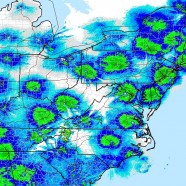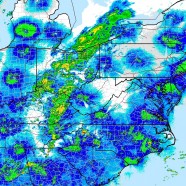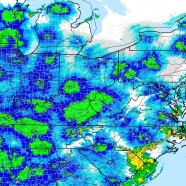Radar Migration September 21, 2015
Here we go again! This was the radar last night around 11:00PM EST, full of nocturnal migrant birds pouring to the south after yesterday’s cold front. Go out and find them this morning and then their friends (or maybe more accurately foes) in the sky with diurnal raptor migration going on all day. Good birding to you!
Read MoreRadar Migration September 11, 2015
This was the eastern radar a few hours after sunset last night – wow! What did you see out there this morning? It seems like there were many thrushes in flight overnight, and I found Catbird City outside a few hours ago. Here comes the next front through the Midwest and then the Northeast today, and we need the water. It should be good early week period for all sorts of passerines and raptors. Scott Kruitbosch Conservation & Outreach Coordinator
Read MoreRadar Migration September 10, 2015
This eastern radar screenshot was taken just before midnight as the birds have lifted off with extremely heavy nocturnal migration occurring everywhere to the west of the cold front on those lovely northerly winds. New England is being mostly shut out of the passerine movement tonight as precipitation remains over the region. The cool air will continue to pour in behind the front making for a strong diurnal raptor migration day Friday at hawk watch sites, and then a great Saturday morning for everyone in the Northeast. Scott Kruitbosch Conservation & Outreach...
Read MoreMelanistic House Sparrow (Passer domesticus)
This is one House Sparrow (Passer domesticus) I have never seen before! I took these shots last weekend, the bird being part of a group of well over 100 House Sparrows. The photos are very true to real life appearance and have not been heavily edited. Do you know why it is so dark? It appears to be melanistic which means that the dark-colored pigment melanin in the feathers was produced at higher than normal levels creating an abnormal color. The opposite is known as leucism where pigments are produced at less than normal levels or in an unexpected pattern. Melanism in small songbirds is...
Read MoreNorthern Saw-whet Owl movement continues
If you are anywhere in New England or the Mid-Atlantic it is a great time to be watching for Northern Saw-whet Owls (Aegolius acadicus). You will not likely find them like this as it is a photo RTPI Affiliate Sean Graesser took while netting and banding more of the species on the move through New Jersey. Nevertheless, you cannot win if you do not play! Take a look at any dense vegetation you come across as they are often near our eye level. They frequently choose evergreen trees to roost in and will stay buried between thick branches or near the trunk. Of course you can always rely on...
Read More








